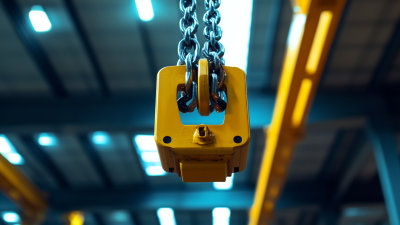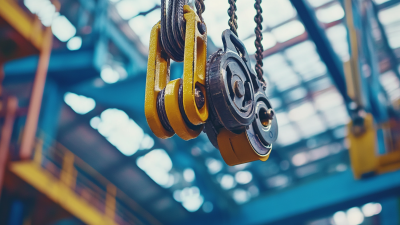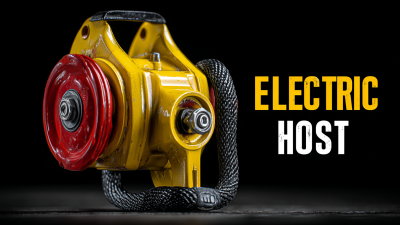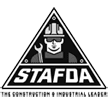
How to Choose the Right Electric Hoist Winch for Your Needs
Choosing the right Electric Hoist Winch can be a daunting task, especially with the myriad of options available in the market today. These versatile machines are essential for lifting and moving heavy objects, making them invaluable in construction sites, warehouses, and various industrial applications. Understanding the different types of Electric Hoist Winches, including their load capacities, features, and operational methods, is crucial for making an informed decision. Whether you require a portable option for occasional use or a robust model for heavy-duty lifting, this guide will walk you through the key considerations necessary to select the Electric Hoist Winch that best suits your unique needs. By evaluating factors such as weight capacity, power source, and safety features, you can ensure that your investment enhances productivity while upholding safety standards.

Understanding Different Types of Electric Hoist Winches
When selecting the right electric hoist winch, it's essential to understand the different types available, as each is designed for specific applications.
Electric chain hoists are among the most popular options, particularly in industrial settings. They provide a robust and reliable lifting solution for heavy loads, typically ranging from a few hundred to several tons. The strength of the chain and the hoist's lifting capacity must be matched to the intended load to ensure safety and efficiency in operation.
Another type to consider is the electric wire rope hoist, which is well-suited for tasks requiring higher lifting heights and speed. These hoists utilize a steel wire rope instead of a chain, allowing for a smoother lift and better performance in outdoor environments. They are commonly used in construction, shipping, and material handling. Additionally, some winches are designed for specific industries, such as marine applications or automotive repairs, providing specialized features that cater to particular environmental challenges and load types. Assessing the operational environment and load requirements is crucial in making an informed choice.
Key Factors to Consider When Choosing an Electric Hoist Winch
When selecting the right electric hoist winch for your needs, it's essential to consider several key factors that can significantly affect performance and efficiency. According to a market research study, the global electric hoist market is projected to exceed USD 220 million, reflecting a growing demand in various industries. Understanding the load capacity, lift height, and duty cycle of the hoist is crucial for ensuring that it can handle the specific tasks required. Additionally, the power source and control mechanisms should align with the operational environment to maximize efficiency.
Tips: Always evaluate the specific weight you plan to lift, as choosing an electric hoist with a capacity well above your needs can enhance safety and prolong the equipment's lifespan. Also, consider the hoist’s mobility—some models are designed for static use, while others allow for portability, offering greater versatility in different job sites.
Another important consideration is the level of technological features available in various hoist models. Some come equipped with advanced safety systems and remote control capabilities that can streamline operations and mitigate risks in high-stakes environments. Research shows that features like overload protection can prevent accidents while ensuring compliance with industry standards.
Comparing Load Capacities: What You Need to Know
When selecting the right electric hoist winch for various applications, comparing load capacities is crucial. Different projects require different lifting strengths, and understanding the load capacity of your chosen winch can prevent accidents and improve efficiency. Electric hoists typically feature load ratings that indicate the maximum weight they can lift safely. For instance, a hoist with a lower capacity may be suitable for light materials, whereas heavy-duty projects necessitate equipment that can handle greater weights. Always ensure the hoist exceeds your load requirements for safety.
Tips: Before making a purchase, consider your project requirements, including the maximum weight, the lifting height, and the environment in which the hoist will operate. If the winch is to be frequently used for various loads, you might want to opt for a model with a higher capacity than your highest anticipated load to allow for versatility. Additionally, keep in mind the power supply and ensure that it matches your operational needs.
Additionally, be aware that various manufacturers provide different features beyond load capacity, such as speed controls or remote operation. Evaluating these features in conjunction with the load capacity can help you choose the right electric hoist winch that best aligns with your overall lifting requirements.

Electric Hoist Winch Features and Their Importance
When selecting an electric hoist winch, understanding its features is essential for ensuring it meets your specific needs. Key characteristics such as lifting capacity, speed, and control mechanisms play a significant role in determining the right fit for your tasks. A winch with an appropriate lifting capacity tailored to the weight of the loads you'll be handling is crucial for safety and efficiency. Additionally, speed options can affect the overall productivity of your operations. A winch that allows for variable speed control can help you adapt to different job requirements, enhancing versatility.
Another vital feature is the control method, which can greatly impact user convenience and safety. Electric hoists often come with options like remote control, push-button operation, or even wireless controls. Each type offers distinct advantages: remote controls can enhance safety by keeping operators at a distance, while wired controls offer simplicity and reliability. Furthermore, features such as thermal protection and overload safety systems are critical to preventing malfunctions and prolonging the lifespan of your winch. By carefully assessing these features, you can ensure that the electric hoist winch you choose will meet both safety standards and operational demands effectively.
Electric Hoist Winch Feature Comparison
Common Applications for Electric Hoist Winches
 Electric hoist winches are versatile tools widely used across various industries. One common application is in construction sites, where they are essential for lifting heavy materials, tools, and even workers to elevated heights. Their ability to quickly and efficiently reduce labor time makes them invaluable for building projects. In warehouses, electric hoist winches facilitate the moving of goods, allowing for easier loading and unloading of trucks, thus enhancing operational efficiency.
Electric hoist winches are versatile tools widely used across various industries. One common application is in construction sites, where they are essential for lifting heavy materials, tools, and even workers to elevated heights. Their ability to quickly and efficiently reduce labor time makes them invaluable for building projects. In warehouses, electric hoist winches facilitate the moving of goods, allowing for easier loading and unloading of trucks, thus enhancing operational efficiency.
When selecting an electric hoist winch, always consider the specific needs of your application. For instance, if you're working in a confined space, opt for models that are compact and portable. Additionally, ensure the hoist has a sufficient weight capacity for the tasks at hand.
Tips: Regularly maintain your electric hoist winch to ensure longevity and operational safety. Checking cables for fraying and inspecting motor functionality can prevent accidents and costly repairs. Furthermore, training all operators on proper usage will significantly reduce the risk of misuse, making your work environment safer and more efficient.
Related Posts
-

Understanding Electric Hoist Specifications for Global Buyers
-

Rising Above Tariffs: How China's Best Electric Hoist Winches Thrive in Trade Tensions
-

7 Reasons Electric Hoists are the Ultimate Solution for Your Lifting Needs
-

Discover the Future of Lifting Solutions with Our Innovative Electric Chain Hoist
-

Transforming Industries: Real-World Applications of the Best Electric Hoist Winch in Heavy Lifting Solutions
-

Unveiling the Future of Best Electric Hoists in 2025 Industry Trends and Performance Comparisons
Copyright ©2024 Elephant Lifting Products | All rights reserved.
38381 N Robert Wilson Rd, Gonzales, LA 70737 USA
Toll Free: (888) 844-6113 | Phone: (225) 644-6113 | Fax: (225) 644-6695
Email: sale@floralift.org




